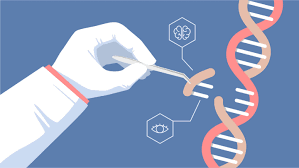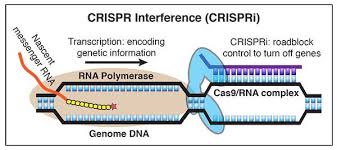CRISPR-CAS9 for UPSC
CRISPR-CAS9 for UPSC- Genetic Engineering Background
Genetic engineering as method of introducing new genetic elements into organisms has been around since the 1970s. One drawback of this technology however has been the random nature with which the DNA is inserted into the hosts genome. This can impair or alter other genes within the organism. Methods were sought which targeted the inserted genes to specific sites within an organism genome.
CRISPR-CAS9 for UPSC – Genome Editing Introduction
Genome editing, or genome engineering, or gene editing, is a type of genetic engineering in which DNA is inserted, deleted, modified or replaced in the genome of a living organism using engineered nucleases. These nucleases create site-specific double-strand breaks (DSBs) at desired locations in the genome. The induced double-strand breaks are repaired through the end- joining or recombination, resulting in targeted mutations. Unlike early genetic engineering techniques that randomly inserts genetic material into a host genome, genome editing targets the insertions to site specific locations. Four families of engineered nucleases are used to perform this.
1) Meganucleases
2) Zinc finger nucleases (ZFNs)
3) Transcription activator-like effector-based nucleases (TALEN)
4) Clustered regularly interspaced short palindromic repeats (CRISPR)-CAS9 system.

CRISPR-CAS9 for UPSC – CISPR Introduction
CRISPR (clustered regularly interspaced short palindromic repeats) refers to a family of DNA sequences found in the genomes of prokaryotic organism. These sequences are derived from DNA fragments of bacteriophages that had previously infected the prokaryote. They are used to detect and destroy DNA from similar bacteriophages during subsequent infections. Hence these sequences play a key role in the antiviral defense system of prokaryotes.
Cas9 (CRISPR-associated protein 9) is an enzyme that uses CRISPR sequences as a guide to recognize and cleave specific strands of DNA that are complementary to the CRISPR sequence. Cas9 enzymes together with CRISPR sequences form the basis of a technology known as CRISPR-Cas9 that can be used to edit genes within organisms. They are also referred to as molecular scissors, capable of cutting strands of DNA. CRISPR technology is a simple yet powerful tool to alter DNA sequences and modify gene function. It has a wide variety of applications including correcting genetic defects, treating, preventing the spread of diseases, improving crops and regulating bacterial immunity.

CRISPR-CAS9 for UPSC – CRISPR-Cas9 as a genome editing tool
The genomes of various organisms encode a series of messages and instructions within their DNA sequences. Genome editing involves changing those sequences, thereby changing the messages. This can be done by inserting a cut or break in the DNA and tricking a cell’s natural DNA repair mechanisms into introducing the changes one wants. CRISPR-Cas9 provides a means to do so. The genome editing requires two components: a guide RNA and the Cas9 protein.
The RNA plus the protein (Cas9) cut like a pair of scissors the DNA at that site, and ideally nowhere else. Once the DNA is cut, the cell’s natural repair mechanisms kick in and work to introduce mutations or other changes to the genome. There are two ways this can happen. (University), one repair method involves gluing the two cuts back together. Scientists can supply the DNA template of their choosing, thereby writing-in any gene they want, or correcting a mutation.

CRISPR-CAS9 for UPSC – Benefits
CRISPR-Cas9 has become popular in recent years. Church notes that the technology is easy to use and is about four times more efficient than the previous best genome-editing tool (called TALENS). CRISPR technology has also been applied in the food and agricultural industries to engineer probiotic cultures and to vaccinate industrial cultures (for yogurt, for example) against viruses. It is also being used in crops to improve yield, drought tolerance and nutritional properties.
One other potential application is to create gene drives. These are genetic systems, which increase the chances of a particular trait passing on from parent to offspring. Eventually, over the course of generations, the trait spreads through entire populations. Gene drives can aid in controlling the spread of diseases such as malaria by enhancing sterility among the disease vector – female Anopheles gambiae mosquitoes
CRISPR-CAS9 for UPSC – Drawbacks
However, CRISPR-Cas9 is not without its drawbacks. The genome-editing efficiencies can vary. There is also the phenomenon of “off-target effects,” where DNA is cut at sites other than the intended target. This can lead to the introduction of unintended mutation. The many potential applications of CRISPR technology raise questions about the ethical merits and consequences of tampering with genomes. Case in point is potential ecological impact of using gene drives. An introduced trait could spread beyond the target population to other organisms through crossbreeding. Gene drives could also reduce the genetic diversity of the target population.
CRISPR-CAS9 for UPSC – Germline Editing
Making genetic modifications to human embryos and reproductive cells such as sperm and eggs is known as germline editing. Since changes to these cells can be passed on to subsequent generations, using CRISPR technology to make germline edits has raised a number of ethical concerns.
This site is aimed at providing resources in the form of syllabus, analysis, solved papers, model papers,books and other resources for aspirants of several exams conducted by the Public Service Commissions(PSCs) across the country. It is our endeavor to provide high quality exam specific content to students in English, Hindi and other state specific languages. To buy high quality material for your entire preparation please fill the form below.
Read More: Biodiversity for UPSC – PCS